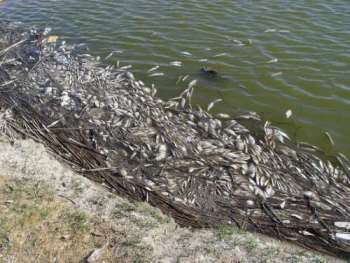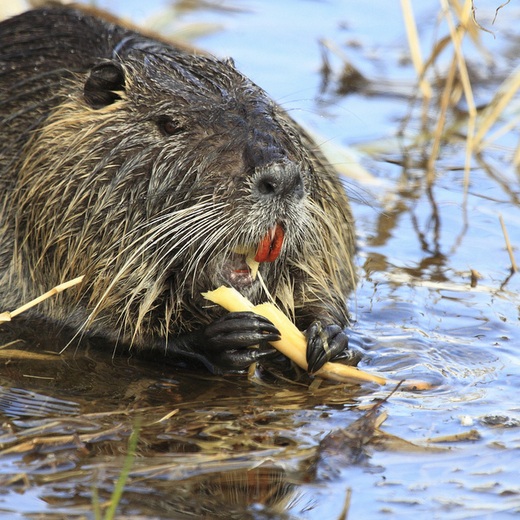Climate Change Could Lead to More Massive Fish Kills in Texas

Photo by Michael Hooper courtesy of USGS.
Dead fish washed ashore during a toxic bloom of golden algae in Canyon Lakes in Lubbock, Texas.
From the Asian Carp to the Zebra Mussel, Texas has its fair share of invasive species. Some of them get a lot of attention (I’m looking at you, voracious feral hog). Others tend to sneak under the radar even when they damage ecosystems.
Take Golden Algae. Originally from Europe, the microscopic plant was discovered on the Pecos River in 1985 when an algae bloom killed hundreds of thousands of fish. Since then, it has colonized other Texas river basins and killed millions more fish. Unlike deadly algae blooms in the Gulf of Mexico that kill fish by taking all the oxygen, golden algae is, itself, toxic. Under the right circumstances, it produces a poison that kills fish, bivalves (and probably any other animal with gills) in the affected waters.
So, it’s no surprise that scientists are trying to learn about it.
Just this weekend the US Geological Survey announced the results of one study that could hold answers to what causes the algae to spread, and points to a troubling relationship between the spread of the algae and global climate change.
In the study, researchers from Texas Tech and the USGS show how “salinity is the most important known variable influencing Golden Algae distribution and bloom formation in inland waters.” In other words, the saltier a lake or reservoir is, the more habitable it will be to this algal invader.
That might not bode well for Texas water ways, and the reason is climate change, which could make our lakes and rivers saltier than ever, according to the USGS.
Climate change could play a major role in future occurrences because the projected rise in temperatures and change in precipitation patterns may lead to higher salinity levels. Higher temperatures could lead to more water evaporating from reservoirs, which can create higher salinity levels.
One reason that could be a problem is that high salinity not only appears to encourage the alga to colonize a body of water, it encourages it to bloom. There are several lakes in Texas where Golden Algae is present but is not currently known to bloom.
“If future increases in salinity due to climate change were to happen, then those places and other that we don’t know about perhaps could start blooming and causing problems,” Reynaldo Patino, USGS scientist and lead author of the study told StateImpact Texas.
An earlier study has shown how climate change and other human influence has also led to decreased inflows into reservoirs, another factor that could lead to higher salinity and, therefore, more algae blooms.
There is also some potentially good news in the most recent study.For one, it does not appear that the arrival the algae in 1985 was due to sudden change in water quality in Texas brought by climate change. More likely, the water could have supported algae for years before it got here. It just happened to be introduced at that time (through human introduction, or even piggybacking on a bird or being blown in by the wind).
“That finding actually supports what some other people have suggested that the invasion of Golden Alga in Texas is a relatively recent event and it essentially happened when it was first observed,” said Dr. Patino.
He says the study could also help officials in their battle against the deadly algae blooms.
“There may be stretches of rivers or there may be some reservoirs that already have golden alga, but they are lower salinity,” he said. “The point there would be for a management agency, perhaps, to try and keep those lakes the way they are so they don’t start showing Golden alga blooms.”

